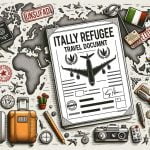Are you an Italian refugee seeking to travel abroad? The Italian Refugee Travel Document Visa is a crucial document that allows refugees to travel outside of Italy. This article serves as a comprehensive guide to understanding the history, eligibility, application process, benefits, challenges, and tips for a successful application for the Italian Refugee Travel Document Visa.
The history of the Italian Refugee Travel Document Visa dates back to provide essential travel documentation for refugees who have been granted asylum or subsidiary protection in Italy. This visa allows them to travel internationally when their national passport is not available or recognized.
Eligibility and requirements for obtaining the Italian Refugee Travel Document Visa are essential aspects that applicants need to be familiar with before starting the application process. From specific residency requirements to supporting documents, this section will provide detailed information on what is needed for a successful application.
The History of Italian Refugee Travel Document Visa
The history of the Italian Refugee Travel Document Visa dates back to the aftermath of World War II, when Europe was grappling with the resettlement of millions of displaced persons. Italy, like many other European countries, saw an influx of refugees seeking asylum and a new place to call home.
In response to this humanitarian crisis, the Italian government introduced the refugee travel document visa as a means to facilitate the legal travel and resettlement of refugees within and outside the country.
Historically, the Italian Refugee Travel Document Visa has provided countless individuals and families with the opportunity to rebuild their lives in safety and security. Over the years, it has evolved to meet the changing needs of refugees, offering additional support and flexibility in travel arrangements. Today, the visa stands as a symbol of Italy’s commitment to protecting and supporting those fleeing persecution and conflict.
Throughout its history, the Italian Refugee Travel Document Visa has been instrumental in bridging the gap between displacement and durable solutions for refugees. By acknowledging and addressing their specific needs for international travel, Italy has played a key role in facilitating their access to education, employment opportunities, family reunification, and medical care. This rich history underscores Italy’s dedication to upholding its humanitarian responsibilities towards refugees and providing them with avenues for building brighter futures.
- Key Milestones in the Evolution of Italian Refugee Travel Document Visa
- Establishment after World War II
- Expansions to include additional support services
- Adaptations to address contemporary challenges
- Impact on Refugees’ Lives
- Facilitated safe travel for resettlement
- Enabled access to essential services abroad
- Strengthened prospects for integration and self-sufficiency
Eligibility and Requirements for Italian Refugee Travel Document Visa
Eligibility Criteria
To be eligible for an Italian refugee travel document visa, individuals must first have been recognized as refugees by the Italian government. This means that they have been forced to flee their home country due to persecution, war, or violence and have been granted protection in Italy. In addition to this, applicants must also meet the general requirements for a travel document visa, which include having a valid passport and a legitimate reason for traveling internationally.
Documentation and Proof of Status
Applicants are required to provide documentation proving their status as refugees in Italy. This may include their official refugee recognition letter, identification documents, and any other relevant paperwork. It is important to ensure that all documentation is up-to-date and accurately reflects the applicant’s current refugee status. Additionally, proof of financial means to support the trip and evidence of accommodation arrangements may also be required.
Interview Process
In some cases, applicants may be required to attend an interview as part of the visa application process. During the interview, individuals will need to demonstrate their need for international travel and provide additional information about their refugee status. It is important to prepare thoroughly for the interview and be ready to answer questions related to the purpose of the trip and how it aligns with their refugee status in Italy.
It is crucial for individuals seeking an Italian refugee travel document visa to carefully review the specific eligibility requirements and gather all necessary documentation before applying. Meeting these criteria will increase their chances of a successful visa application.
How to Apply for an Italian Refugee Travel Document Visa
Italy is known for being a popular destination for refugees seeking safety and asylum. The Italian Refugee Travel Document Visa is an important tool that allows refugees to travel internationally with ease. This visa allows refugees to visit other countries for various purposes such as work, study, or family reunification. With the Italian Refugee Travel Document Visa, refugees can have the opportunity to rebuild their lives in a new environment.
To apply for an Italian Refugee Travel Document Visa, there are specific steps and requirements that applicants must follow. Firstly, applicants must ensure that they meet the eligibility criteria which include holding a valid refugee status in Italy and having a genuine reason for traveling abroad.
Additionally, applicants will need to gather various documents such as their passport, proof of refugee status, travel itinerary, and financial resources. It’s important to carefully review the list of requirements to avoid any delays in the application process.
Once all the necessary documents have been obtained, applicants can submit their visa application at the nearest Italian consulate or embassy in their home country. It’s crucial to schedule an appointment in advance and be prepared for an interview during the application process.
Upon submission, applicants should be diligent in following up on their applications and providing any additional information if required. The processing time for an Italian Refugee Travel Document Visa can vary, so it’s advisable to apply well in advance of any planned travel dates.
| Italian Refugee Travel Document Visa Application Requirements | Description |
|---|---|
| Valid refugee status in Italy | Applicants must hold a valid refugee status issued by Italian authorities. |
| Passport | Applicants are required to provide a valid passport with remaining validity of at least six months. |
| Proof of travel itinerary | Documentation such as flight reservations or travel bookings demonstrating the purpose and duration of the trip. |
| Financial resources | Evidence of sufficient funds to cover expenses during the trip. |
Benefits of Having an Italian Refugee Travel Document Visa
Freedom of Movement
One of the most significant benefits of having an Italian Refugee Travel Document Visa is the freedom of movement it grants to refugees. With this visa, individuals can travel outside of Italy to other countries within the Schengen Area and, in some cases, beyond. This means that refugees have the opportunity to visit family members, pursue educational opportunities, or seek employment in other European countries without fear of being denied entry.
Access to Healthcare and Social Services
Having an Italian Refugee Travel Document Visa also allows holders access to healthcare and social services while traveling abroad. In many cases, refugees may require medical treatment or assistance while outside of Italy, and with this visa, they can access necessary healthcare services without barriers. Additionally, access to social services such as housing support or financial aid can be invaluable for refugees who are seeking stability and security in their new host country.
Opportunities for Family Reunification
Another benefit of holding an Italian Refugee Travel Document Visa is the opportunity for family reunification. Refugees who have been granted this visa may be able to sponsor family members from their home country to join them in Italy or travel together to other countries within the Schengen Area. This can provide much-needed emotional support and a sense of belonging for individuals who have been separated from their loved ones due to conflict or persecution in their home country.
Challenges and Common Issues With Italian Refugee Travel Document Visa Applications
Obtaining an Italian refugee travel document visa is often a long and complex process, and there are many challenges that applicants may face along the way. One common issue is the extensive documentation required to prove refugee status and eligibility for the travel document visa. This can include providing evidence of persecution in their home country, proof of residence in Italy, and other supporting documents.
Another challenge is navigating the bureaucratic process of applying for the Italian refugee travel document visa. This often involves dealing with different government agencies, completing various forms, and attending interviews and appointments. The language barrier can also be a significant obstacle for many refugees who may not be fluent in Italian or English, the languages commonly used in the application process.
Furthermore, another issue faced by applicants is the lengthy processing times for Italian refugee travel document visa applications. The wait for a decision on an application can take several months or even years due to backlogs and resource constraints within the immigration authorities. This extended waiting period can cause anxiety and uncertainty for refugees seeking to travel internationally.
Given these challenges, it is essential for applicants to seek assistance from legal experts or immigration advocates who specialize in assisting refugees with their travel document visa applications. These professionals can provide guidance on gathering the necessary documentation, navigating the application process, and advocating on behalf of refugees throughout their application journey.
| Challenges | Common Issues |
|---|---|
| Extensive documentation requirements | Navigating bureaucratic processes |
| Language barriers | Lengthy processing times |
Tips for a Successful Italian Refugee Travel Document Visa Application
Traveling as a refugee can be a challenging and daunting process, but obtaining an Italian Refugee Travel Document Visa can make it easier for individuals to travel internationally. Here are some tips for a successful Italian Refugee Travel Document Visa application:
1. Research the requirements: Before beginning the application process, it is crucial to thoroughly research the eligibility and requirements for an Italian Refugee Travel Document Visa. This may include gathering necessary documentation such as proof of refugee status, identification documents, and a valid reason for travel.
2. Seek assistance if needed: If navigating the visa application process seems overwhelming, seeking assistance from organizations or legal professionals specializing in refugee issues can be helpful. They can provide guidance on the application process and ensure all requirements are met.
3. Be honest and thorough: When completing the visa application, honesty and thoroughness are key. Providing accurate information and ensuring all required documentation is included will increase the likelihood of a successful application.
By following these tips and being diligent in the application process, individuals can increase their chances of successfully obtaining an Italian Refugee Travel Document Visa. With this important travel document, refugees can have greater flexibility and freedom in traveling internationally for various reasons such as education, employment opportunities, or reuniting with family members.
Resources and Support for Italian Refugees Applying for Travel Document Visa
In conclusion, the Italian Refugee Travel Document Visa provides an important opportunity for refugees from Italy to travel internationally. The history of this visa reflects the need for a solution to the travel limitations faced by Italian refugees, and its availability is a positive development in addressing these challenges.
Eligibility and requirements for the Italian Refugee Travel Document Visa are clearly outlined, and it is made clear that with the correct documentation, refugees can apply for this visa. The benefits of obtaining this visa are numerous, including the ability to travel freely outside of Italy, and open up opportunities for work, education, and family reunification.
However, it is crucial to acknowledge that challenges and common issues may arise during the application process. With proper guidance and support from resources available to Italian refugees applying for the travel document visa, many of these challenges can be mitigated or addressed effectively. By following tips for a successful application, including ensuring all required documents are in order and seeking assistance when needed, applicants stand a better chance of obtaining their Italian Refugee Travel Document Visa.
Frequently Asked Questions
Which Countries Accept Italy Refugee Travel Document?
Italy’s Refugee Travel Document is generally accepted for travel to most European countries, including those within the Schengen Area. However, it’s important to check with the specific country’s embassy or consulate for any entry requirements or restrictions.
Can I Travel to USA With Italian Travel Document?
As of 2021, Italy’s Refugee Travel Document does not automatically grant its holder entry into the United States. Travelers with this document need to apply for a visa or an ESTA (Electronic System for Travel Authorization) in advance to visit the USA.
Can I Travel With Just a Refugee Travel Document?
While a Refugee Travel Document can facilitate international travel for refugees and stateless individuals, it’s essential to remember that each country has its own rules regarding entry and visas. It’s important to research and comply with the specific requirements of the destination country before traveling.

I’m a passionate traveler, writer, and Italophile. My fascination with Italy’s history, art, and culture has led me on countless adventures across the Italian landscape. Through “I Live Italy,” I share my love for this extraordinary country and aims to inspire others to explore its boundless beauty.





